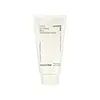What's inside
What's inside
 Key Ingredients
Key Ingredients

 Benefits
Benefits

 Concerns
Concerns

 Ingredients Side-by-side
Ingredients Side-by-side

Water
Skin ConditioningGlycerin
HumectantMyristic Acid
CleansingLauric Acid
CleansingPotassium Hydroxide
BufferingStearic Acid
CleansingGlyceryl Stearate
EmollientPalmitic Acid
EmollientGlycol Distearate
EmollientLauryl Hydroxysultaine
CleansingPolyquaternium-22
Limonene
PerfumingSodium Chloride
MaskingSodium Metaphosphate
BufferingCitrus Limon Peel Oil
MaskingCitrus Aurantium Dulcis Peel Oil
MaskingCitral
PerfumingTocopherol
AntioxidantTocopheryl Acetate
AntioxidantOlea Europaea Fruit Oil
MaskingWater, Glycerin, Myristic Acid, Lauric Acid, Potassium Hydroxide, Stearic Acid, Glyceryl Stearate, Palmitic Acid, Glycol Distearate, Lauryl Hydroxysultaine, Polyquaternium-22, Limonene, Sodium Chloride, Sodium Metaphosphate, Citrus Limon Peel Oil, Citrus Aurantium Dulcis Peel Oil, Citral, Tocopherol, Tocopheryl Acetate, Olea Europaea Fruit Oil
Water
Skin ConditioningGlycerin
HumectantSodium Cocoyl Glycinate
CleansingSodium Lauroyl Glutamate
Sodium Hyaluronate
HumectantHyaluronic Acid
HumectantHydrolyzed Hyaluronic Acid
HumectantSodium Acetylated Hyaluronate
HumectantHydroxypropyltrimonium Hyaluronate
Hydrolyzed Sodium Hyaluronate
Skin ConditioningSodium Hyaluronate Crosspolymer
HumectantPotassium Hyaluronate
Skin ConditioningPanthenol
Skin ConditioningAllantoin
Skin ConditioningTrehalose
HumectantTocopherol
AntioxidantHamamelis Virginiana Extract
AntiseborrhoeicCamellia Sinensis Leaf Extract
AntimicrobialChamomilla Recutita Extract
Skin ConditioningButylene Glycol
HumectantDipropylene Glycol
HumectantHydroxypropyl Starch Phosphate
Glyceryl Stearate Se
EmulsifyingPotassium Benzoate
PreservativeSodium Chloride
MaskingPolyquaternium-67
Sodium Acetate
Buffering1,2-Hexanediol
Skin ConditioningCitric Acid
BufferingEthylhexylglycerin
Skin ConditioningDisodium EDTA
Malachite Extract
AntioxidantWater, Glycerin, Sodium Cocoyl Glycinate, Sodium Lauroyl Glutamate, Sodium Hyaluronate, Hyaluronic Acid, Hydrolyzed Hyaluronic Acid, Sodium Acetylated Hyaluronate, Hydroxypropyltrimonium Hyaluronate, Hydrolyzed Sodium Hyaluronate, Sodium Hyaluronate Crosspolymer, Potassium Hyaluronate, Panthenol, Allantoin, Trehalose, Tocopherol, Hamamelis Virginiana Extract, Camellia Sinensis Leaf Extract, Chamomilla Recutita Extract, Butylene Glycol, Dipropylene Glycol, Hydroxypropyl Starch Phosphate, Glyceryl Stearate Se, Potassium Benzoate, Sodium Chloride, Polyquaternium-67, Sodium Acetate, 1,2-Hexanediol, Citric Acid, Ethylhexylglycerin, Disodium EDTA, Malachite Extract
 Reviews
Reviews

Ingredients Explained
These ingredients are found in both products.
Ingredients higher up in an ingredient list are typically present in a larger amount.
Glycerin is already naturally found in your skin. It helps moisturize and protect your skin.
A study from 2016 found glycerin to be more effective as a humectant than AHAs and hyaluronic acid.
As a humectant, it helps the skin stay hydrated by pulling moisture to your skin. The low molecular weight of glycerin allows it to pull moisture into the deeper layers of your skin.
Hydrated skin improves your skin barrier; Your skin barrier helps protect against irritants and bacteria.
Glycerin has also been found to have antimicrobial and antiviral properties. Due to these properties, glycerin is often used in wound and burn treatments.
In cosmetics, glycerin is usually derived from plants such as soybean or palm. However, it can also be sourced from animals, such as tallow or animal fat.
This ingredient is organic, colorless, odorless, and non-toxic.
Glycerin is the name for this ingredient in American English. British English uses Glycerol/Glycerine.
Learn more about GlycerinChances are, you eat sodium chloride every day. Sodium Chloride is also known as table salt.
This ingredient has many purposes in skincare: thickener, emulsifier, and exfoliator.
You'll most likely find this ingredient in cleansers where it is used to create a gel-like texture. As an emulsifier, it also prevents ingredients from separating.
There is much debate on whether this ingredient is comedogenic. The short answer - comedogenic ratings don't tell the whole story. Learn more about comegodenic ratings here.
The concensus about this ingredient causing acne seems to be divided. Research is needed to understand if this ingredient does cause acne.
Scrubs may use salt as the primary exfoliating ingredient.
Learn more about Sodium ChlorideTocopherol (also known as Vitamin E) is a common antioxidant used to help protect the skin from free-radicals and strengthen the skin barrier. It's also fat soluble - this means our skin is great at absorbing it.
Vitamin E also helps keep your natural skin lipids healthy. Your lipid skin barrier naturally consists of lipids, ceramides, and fatty acids. Vitamin E offers extra protection for your skin’s lipid barrier, keeping your skin healthy and nourished.
Another benefit is a bit of UV protection. Vitamin E helps reduce the damage caused by UVB rays. (It should not replace your sunscreen). Combining it with Vitamin C can decrease sunburned cells and hyperpigmentation after UV exposure.
You might have noticed Vitamin E + C often paired together. This is because it is great at stabilizing Vitamin C. Using the two together helps increase the effectiveness of both ingredients.
There are often claims that Vitamin E can reduce/prevent scarring, but these claims haven't been confirmed by scientific research.
Learn more about TocopherolWater. It's the most common cosmetic ingredient of all. You'll usually see it at the top of ingredient lists, meaning that it makes up the largest part of the product.
So why is it so popular? Water most often acts as a solvent - this means that it helps dissolve other ingredients into the formulation.
You'll also recognize water as that liquid we all need to stay alive. If you see this, drink a glass of water. Stay hydrated!
Learn more about Water